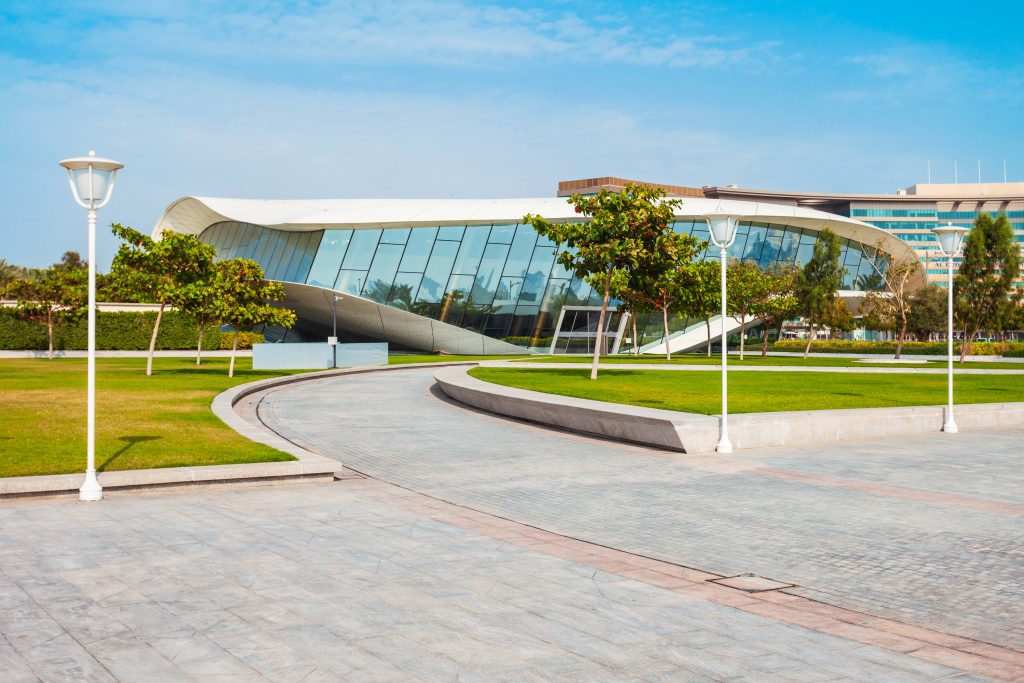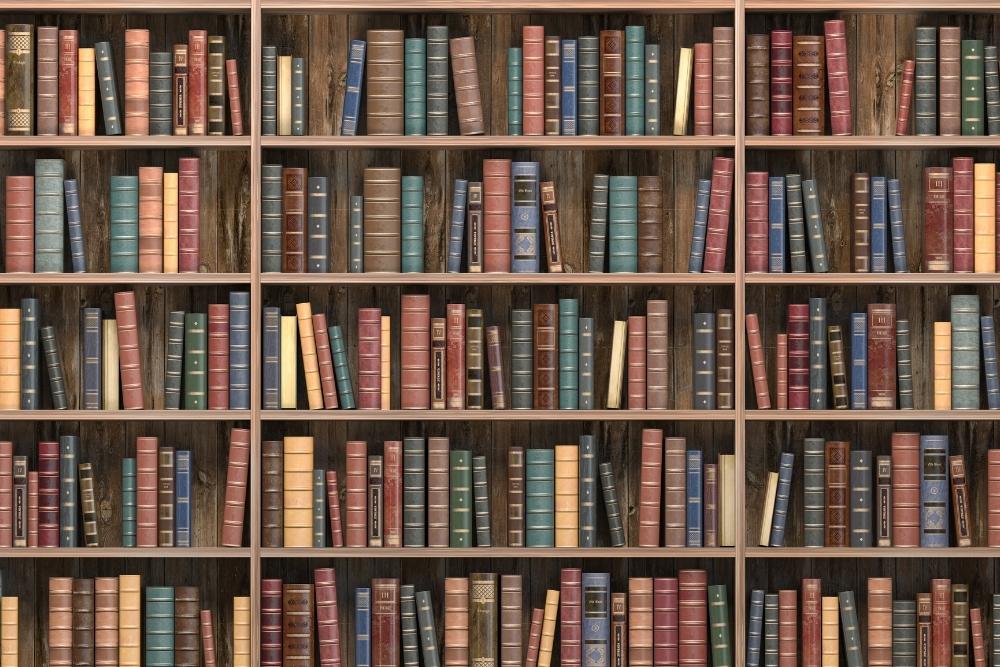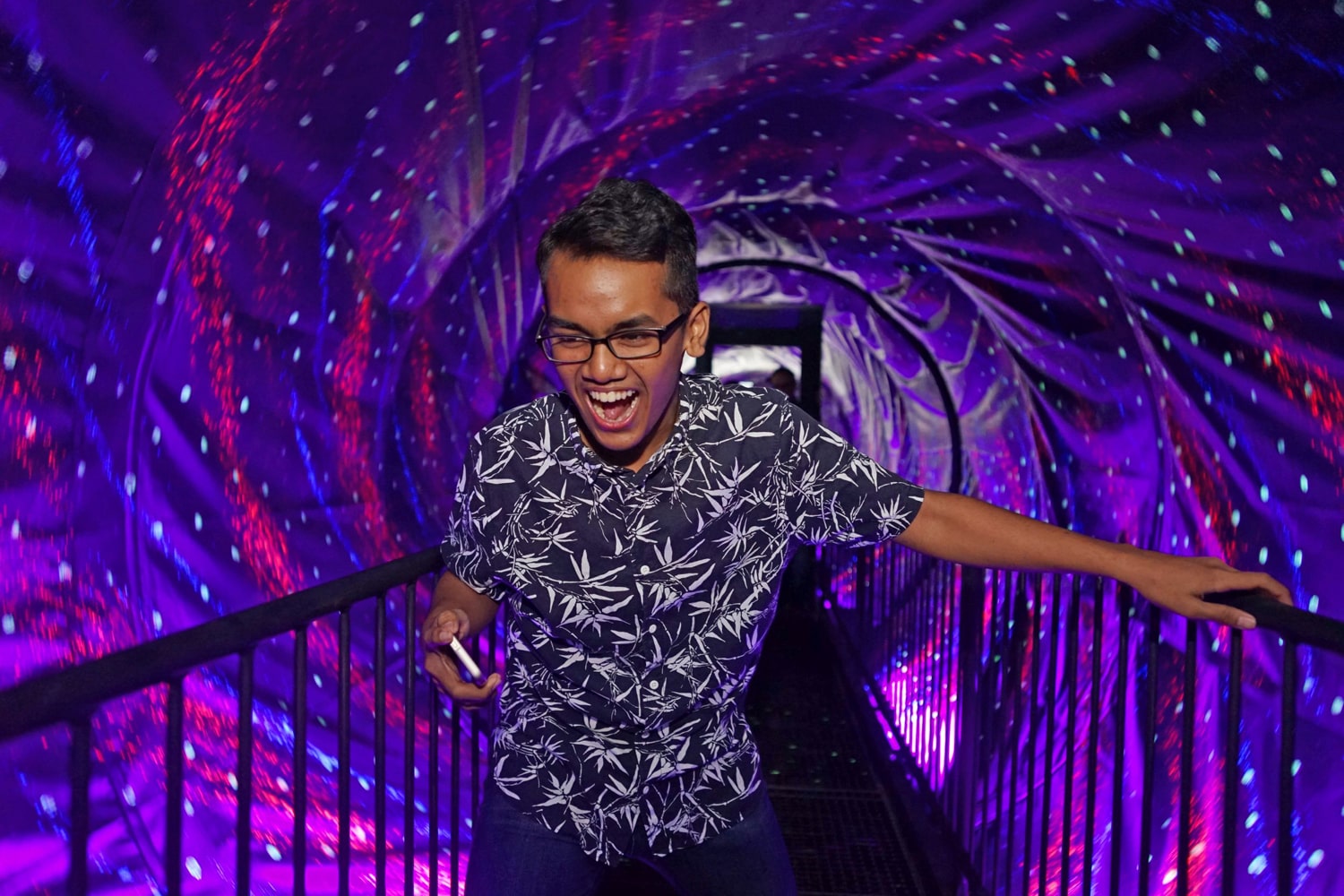When the founders of UAE, led by a united vision, met in Dubai in a small villa to stay united and grow together, they signed the Unification Treaty. That villa became to be known as the Unity House. Over the years, the same villa was converted into the Etihad Museum. This Museum mostly has photos and artifacts used during the treaty signing. The tallest flag in UAE is hoisted. The Museum became a much-visited place, especially by academicians and schools, to get an education in the formation of the United Arab Emirates. This Museum showcases the events that led to the formation of UAE, in which 7 Emirates of UAE joined hands and decided to form one country.
The Etihad Museum has many sections dedicated to one particular aspect of historical Unification. The Museum’s curation is carefully done to maximize appreciation of Unification and the subsequent formation of the UAE. The Museum shifted to its swanky new building in 2022. The Museum’s design, inspired by the shape of a manuscript, with seven columns representing the pens used to sign the original declaration, is both symbolic and awe-inspiring.
Expert historians curate this Museum to provide visitors with an immersive experience of the events that led to the formation of this great nation to be part of the inspirational journey.
Location and Opening Hours
This Museum is in Jumeirah, Cross of 2nd December Street, Dubai, United Arab Emirates. It is at the junction of Satwa and Jumeirah. It can also be reached from the Sheik Zayed Road by alighting at the World Trade Center and taking a feeder bus service to Jumeirah. It is open daily from 10:00 AM to 8:00 PM, allowing visitors to explore its interactive exhibitions and educational initiatives. It’s best to arrive early for a complete experience, as the last entry is permitted at 7:00 PM.
Ticket Prices and Booking
You can book your tickets online at the Etihad Museum website. There are four categories of tickets: a ticket for adults is AED 20/ per person, Students (Ages 5 to Age 25) is AED 10, Summer camp (Ages 5 to Age 12) is AED 500 for season 1, and AED 350 for season 2. Please note that there is no limit for summer camp students. But when booking tickets, you have to upload your details so ticket coupons can be printed and distributed. You can also purchase them at the Museum’s ticket desk upon arrival. The Museum is open daily from 10:00 AM to 8:00 PM, with the last entry at 7:00 PM, ensuring ample time for visitors to immerse themselves in the nation’s heritage.
Exhibits and Collections
The Etihad Museum, a virtual keeper of the United Arab Emirates’ rich history, offers a window into the nation’s federal soul through its carefully preserved exhibits and collections. It houses diverse artifacts that narrate the story of the UAE’s formation, from the earliest postal services to the Unification in 1971. The Museum’s collections include rare stamps, letters, artworks, and archives from the private collection of Mr. Abdulla MT Khoory, president of the Emirates Philatelic Association. These are historical pieces and symbols of the nation’s journey towards unity and independence. The Museum also honors the UAE Armed Forces through exhibitions that reflect their role in the nation’s defense and the values of duty and sacrifice they embody.
The Museum is a testament to modern architecture inspired by the Unification Agreement. Seven leaning columns symbolize the pens that signed the Constitution. Visitors are greeted by a grand sculpture representing the preamble of the UAE constitution, and the walls are adorned with quotes from the Founding Fathers, artistically integrated into the Museum’s design. The artwork of Emirati artist Abdul Qader Al Rais is a centerpiece that captures the attention of the audience before embarking on the historical journey through the Museum’s sections.

The ‘Dreams of Unity’ section, a unique feature of the Museum, takes visitors on a captivating journey back in time. With special effects and music, it displays the story of the Union alongside significant films and personalities that shaped the modern state. The ‘UAE Interactive Map’ is another standout feature, showcasing the pre-Union period with a three-dimensional projection mapping that activates to reveal videos and audio, providing an immersive experience. ‘The Early Years’ exhibition offers a visual narrative of the pre-Union negotiations and displays the circulating national currencies, enriching visitors’ understanding of the region’s history.
Interactive Experiences
A tour of the Etihad Museum in Dubai is not just a visit; it’s an educational journey that offers a comprehensive and engaging experience. The Museum’s design and exhibitions are tailored to provide a dynamic learning environment with various interactive programs and education initiatives. Guests can immerse themselves in experience-driven exhibitions that explore the chronology of events leading to the Unification of the Emirates in 1971, emphasizing the period between 1968 and 1974. The Museum’s interactive features include touchscreens, audio-visual displays, and 3D films that bring the story of the UAE’s founding to life. Additionally, the Museum hosts workshops, guided tours, and live cultural performances, offering a comprehensive and engaging educational journey. The interactive timeline and recreational spaces further enhance the visitor experience, making the Etihad Museum a must-visit destination for those looking to delve into the UAE’s heritage and its founding fathers’ vision. The plans are afoot to add AI power to make learning about UAE more interesting and exhaustive.
Historical Significance
Dubai has different museums that allow visitors to understand its past. When you enter these museums, you will be impressed with the way the past has been preserved to learn from it and ensure that students and visitors can relate its present to its past. The AL Fahidi is about its pastoral farming, old-time trading, fishing, and historical artifacts that date before Christ. It also maps the social fabric of ancient Dubai.
The government of Dubai also wanted to preserve its modern history. This history consists of events that culminated in the formation of the UAE. In hindsight, it was one of the best decisions taken by its founders to unite the seven emirates into one single unit to have a familiar yet powerful destiny. Earlier, this history was seen in the Unification House, where the tallest and biggest flag of the UAE flutters proudly. One would go to this small Villa-type house, where the founders came in 1971 and, while overlooking the majestic Jumeirah beach, decided to bury their differences and form a formidable federation led by Abu Dhabi, the biggest of the seven emirates.
The decision to expand the space for Unification is a powerful testament to Dubai’s growth and evolution. The new, larger space, divided into multiple sections, each communicating a powerful message, reflects Dubai’s commitment to its history and future. This commitment is vividly demonstrated in the new, awe-inspiring Etihad (“Unity”) museum. Curated by experts from top universities, the Museum offers an immersive experience that never fails to captivate its visitors, drawing them into the rich tapestry of Dubai’s history.
The historical questions of “Why” or “When” of Unification have been answered very well in the Museum. When you have a guided tour, the certified tour guide will explain why the Unification was thought and under the stewardship of Shiek Zayed, ably supported by Mr. Sheik Rashid, which was such a huge success. That unification is significant as it is in this meeting, and it was decided about the permanent presidency and prime ministership. Many such decisions were taken, which is why it is important to learn the modern history of Dubai from the archives, library, tours, and visiting different sections of the Etihad Museum.
Architectural Design
The Etihad Museum, a beautiful building that narrates the modern history of the UAE, stands in stark contrast to the Dubai Museum in Bastakiya, which focuses on its history centuries ago. Contemporary history demanded more modern architecture, and the government chose a famous Canadian architecture firm to develop a stellar design that tells the unification story. The renowned Canadian firm Moriyama & Teshima Architects designed the new building to symbolize the country’s Unification. The Museum’s unique design features undulating parabolic curves that mimic the parchment of the unification agreement, with tapering golden columns that evoke the pens used to sign the historic document. This architectural marvel, located adjacent to the historic Union House on the Dubai waterfront, further reinforces its significance as a monument to the UAE’s founding, adding a touch of historical grandeur to its modern design.

The Museum’s façade was designed to capture the waves of the nearby sea. A creative skin of steel roof provides this impression. The curved skin is elegantly reflected in the night. The Museum’s floors and walls are decorated with luxurious materials such as marble and carved stone. One of the facility’s design features is the undergrounds, which are built with sunken courtyards and light wells of different sizes and shapes. These open spaces are all down in the ground, are well-shaped, and light the floor. The circulation path, which also doubles metaphorically as a graphic that connects all spaces, is a re-executed lagoon given water features and thin-lined shade trees to narrate spatially. Thus, the composition comes to life with natural shapes, circulation networks, water bodies, etc. A Small-scaled lagoon with nearby shade trees creates a serene atmosphere and a place for people to relax.
The Museum is divided into many sections, starting with the Visitor pavilion, which has a beautiful façade of intricately scripted Arabic text about Unification. The corner walls are decorated with essential quotes from our founding fathers. As you proceed to the temporary art and exhibition area, you will see a massive art by the famous Emirati artist, Mr. Abdul Qader Rais. Surrounded by glass walls, you will find a single tree called the Unification tree. This plant was planted by Sheikh Muhammed bin Rashi, the ruler of Dubai, and was relocated to the Etihad Museum. Then, there is a Founder’s section with impressive photos of rulers who came together to form the UAE. For each of the 7 founders, there are 7 materials. The first is their images, the second is some of their belongings, the third is images of their interactions with their subjects, and the Fourth is the extensive family tree of each rule. There are more materials, including their biographies and their essential videos. Thus, the founders’ section will vividly give you all the information related to the founders. The following section is “Dreams of Unity,” an audio-video presentation on the events of people who shaped the destiny of UAE by working hard, finding solutions to doubts, and then creating the final draft of the Unification.
The Etihad Museum is more than just a museum; it is a powerful storytelling medium that brings the UAE’s cherished past to life. Through its architecture, interiors, curation, and innovation, the Museum serves as a poignant representation of the country’s history. As a LEED-certified building, it harmoniously merges with the Unification House, Jumeirah Beach, and the Arabian Gulf, serving as a living testament to the UAE’s journey to Unification. It was not designed to be a mere building but rather a platform that engages and connects visitors with the country’s history, beautifully illuminated by a carefully placed lighting system.
Guided Tours
One must have proper guidance if in-depth learning is required. This is true even if you have audio-visual tools available to know about a place. This becomes more challenging if you have no or little knowledge of Arabic. The Etihad Museum of Dubai carries a rich history of the United Arab Emirates, visible only through tours with guides who provide a comprehensive understanding. These tours happen daily at certain indistinct times, and guests will begin at the very genesis of the events leading to the Unification of the Emirates. Customers may use their official website to sign up for guided tours and find detailed tour information, such as timings and booking process. There is also a reserved booking for group and school visits through e-mail, as distinct trips are set up. You can contact the Museum using their mobile number for any clarification or query regarding the visit.
Educational Programs
The Etihad Museum in Dubai offers excellent educational programs for kids of various age groups to make them aware of the country’s history. These programs are conducted by experts at the Museum or notable historians invited to conduct such programs. The educational programs are offered through special exhibitions or summer camps. The management of Dubai Culture and Etihad Museum provides these programs through creative and innovative methodology. For example, it has a program called “Sketching the Museum,” which teaches kids how to sketch and what are the various elements required for sketching. This program then encourages the kids to go ahead and sketch what interests them in the Museum. The Museum also rewards the participating kids. The Museum provides all sketching materials. It also conducts similar programs for “Photography” and “Journalism”.

As the government is trying to encourage the holistic development of kids, such symposiums, summer camps, and connections with the school ecosystem are very beneficial to the kids in understanding the basic fabric of the country and how the Unification in Diversity has been so successful.
Family-Friendly Features.
Most of the Dubai tourist places are family-friendly. Even the Etihad Museum is strictly for the entire family. Many features make it a destination for the whole family. You must wear respectable attire while visiting the Museum, avoid showing adult affection openly, resist smoking, and its policy of encouraging children to see and learn by lowering the tickets for them.
Photography Policies
Photography is prohibited inside the Etihad Museum, as the harsh camera flash or external high-impact lights may damage the susceptible displays. Many of these displays are handwritten quotations and verses, so the ink may fade away if exposed to harsh lights. We always urge visitors to respect the Museum’s “no camera” policy.
Conclusion
Dubai Etihad Museum provides glimpses of the events in history that shaped the UAE. This modern UAE history museum has an incredible collection of quotes, photographs, and artifacts. For an immersive experience, you must head to the Interactive exhibits at Etihad Museum. The joy of learning something so important has had such a massive impact on the geopolitics of the Middle East and the entire world, and it does not cost too much. Dubai government has kept Etihad Museum ticket prices as low as AED 25 for adults and AED 10 for kids.
FAQs:
What is the main focus of exhibits at Etihad Museum?
The exhibits focus on the events and people that led to the formation of the UAE and the signing of the unification treaty in 1971. The main focus areas are a) The events that led to the formation of the federation, b) The founders who came together on that day to sign the treaty, c) The sacrifices and understanding made by the founders, no matter how non-Emirati countries felt, c) What each founder said and meant. You will be part of all these and many more secrets when you visit this place.
Are there any special events or exhibitions held at the Museum?
Special events or exhibitions are held at the Etihad Museum. Dubai Cultures, a government entity, manages and curates these exhibitions, which are regularly announced on its website. These special events or exhibits include the Photography Exhibition of Modern History and the Philately Exhibition (Postal Stamp Collection Exhibition), which have generated significant interest in Unification treaty-related events.
Is there parking available near the Museum?
Yes, the new building that houses the Etihad Museum, Dubai, has underground parking for visitors. External parking is also available inside the Museum. School buses mainly stop here during summer vacation camps.
The parking spaces were created to encourage local residents to visit the Museum, learn its modern history, and appreciate the valiant efforts made by its founding fathers to bury their differences and create a unified country known as the United Arab Emirates.
